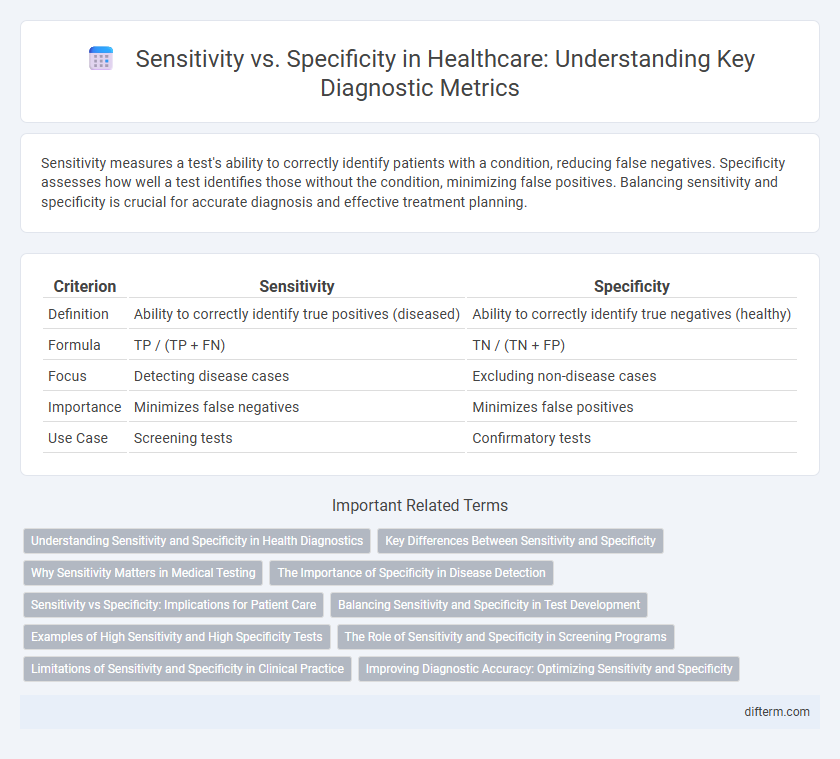Sensitivity measures a test's ability to correctly identify patients with a condition, reducing false negatives. Specificity assesses how well a test identifies those without the condition, minimizing false positives. Balancing sensitivity and specificity is crucial for accurate diagnosis and effective treatment planning.
Table of Comparison
| Criterion | Sensitivity | Specificity |
|---|---|---|
| Definition | Ability to correctly identify true positives (diseased) | Ability to correctly identify true negatives (healthy) |
| Formula | TP / (TP + FN) | TN / (TN + FP) |
| Focus | Detecting disease cases | Excluding non-disease cases |
| Importance | Minimizes false negatives | Minimizes false positives |
| Use Case | Screening tests | Confirmatory tests |
Understanding Sensitivity and Specificity in Health Diagnostics
Sensitivity measures a diagnostic test's ability to correctly identify individuals with a disease, reflecting true positive rates, while specificity assesses the test's ability to accurately exclude those without the disease, indicating true negative rates. High sensitivity is crucial for screening to minimize false negatives, and high specificity is essential in confirmatory testing to reduce false positives. Understanding sensitivity and specificity aids healthcare professionals in selecting appropriate diagnostic tools and interpreting test results for improved patient outcomes.
Key Differences Between Sensitivity and Specificity
Sensitivity measures a test's ability to correctly identify true positives, reflecting how well it detects patients with a condition. Specificity quantifies the test's capacity to correctly identify true negatives, indicating how accurately it excludes individuals without the condition. Key differences include sensitivity prioritizing minimizing false negatives, while specificity focuses on reducing false positives in diagnostic testing.
Why Sensitivity Matters in Medical Testing
Sensitivity measures a medical test's ability to correctly identify patients with a condition, reducing the risk of false negatives. High sensitivity is crucial in screening for serious diseases, ensuring early detection and timely treatment. For conditions like cancer or infectious diseases, prioritizing sensitivity can improve patient outcomes by capturing nearly all true positive cases.
The Importance of Specificity in Disease Detection
Specificity measures a diagnostic test's ability to correctly identify individuals without a disease, minimizing false positives and preventing unnecessary treatments. High specificity is crucial in disease detection to ensure that healthy patients are not misdiagnosed, reducing medical costs and patient anxiety. Accurate specificity enhances the reliability of screening programs, especially for conditions with serious implications like cancer or infectious diseases.
Sensitivity vs Specificity: Implications for Patient Care
Sensitivity measures a test's ability to correctly identify patients with a condition, minimizing false negatives, while specificity assesses its accuracy in ruling out disease, minimizing false positives. High sensitivity is crucial in screening programs to ensure affected individuals receive timely intervention, whereas high specificity reduces unnecessary treatments and anxiety from false alarms. Balancing sensitivity and specificity directly impacts diagnostic accuracy, patient outcomes, and healthcare resource allocation.
Balancing Sensitivity and Specificity in Test Development
Balancing sensitivity and specificity is critical in test development to ensure accurate disease detection and minimize false results. High sensitivity reduces false negatives, crucial for early diagnosis, while high specificity limits false positives, preventing unnecessary treatments. Optimizing this balance tailors tests to specific clinical contexts, improving patient outcomes and diagnostic reliability.
Examples of High Sensitivity and High Specificity Tests
High sensitivity tests like HIV screening are designed to identify nearly all true positive cases, minimizing false negatives and ensuring early detection. High specificity tests such as the PSA test for prostate cancer focus on correctly identifying true negatives, reducing false positives and avoiding unnecessary treatments. Combining tests with high sensitivity and specificity improves diagnostic accuracy, enhancing patient outcomes through precise detection and confirmation.
The Role of Sensitivity and Specificity in Screening Programs
Sensitivity measures a screening test's ability to correctly identify individuals with a disease, minimizing false negatives and ensuring early intervention. Specificity evaluates the test's accuracy in identifying those without the disease, reducing false positives and unnecessary follow-up procedures. Balancing sensitivity and specificity is crucial for optimizing screening programs, maximizing disease detection while minimizing harm and healthcare costs.
Limitations of Sensitivity and Specificity in Clinical Practice
Sensitivity measures a test's ability to correctly identify patients with a disease, while specificity assesses correctly identifying those without it, yet both metrics can be limited by disease prevalence and spectrum bias. High sensitivity may lead to false positives, causing unnecessary anxiety and interventions, whereas high specificity can result in false negatives, delaying diagnosis and treatment. Clinical decisions must integrate sensitivity and specificity with patient history, prevalence data, and other diagnostic tools to minimize misdiagnosis and optimize patient outcomes.
Improving Diagnostic Accuracy: Optimizing Sensitivity and Specificity
Improving diagnostic accuracy requires balancing sensitivity and specificity to reduce false negatives and false positives in medical tests. High sensitivity ensures early disease detection by correctly identifying affected individuals, while high specificity confirms the absence of disease by accurately excluding healthy cases. Optimizing these parameters through advanced algorithms and tailored diagnostic criteria enhances clinical decision-making and patient outcomes.
Sensitivity vs Specificity Infographic

 difterm.com
difterm.com